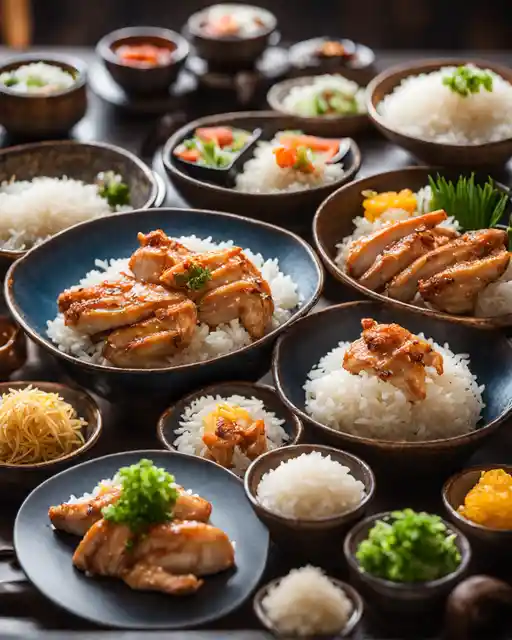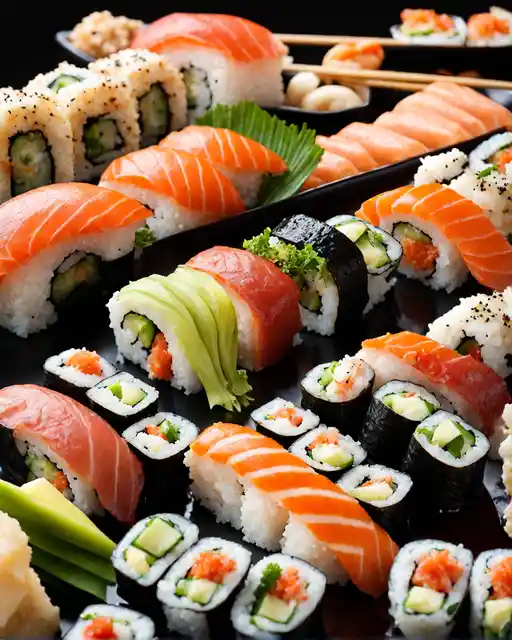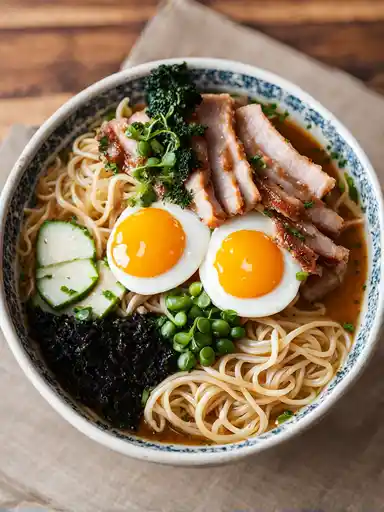Japanese Restaurant: Experience Tokyo’s Vibrant Food Scene
Updated: 25 May 2023
147

Have you ever wanted to travel across the globe to the beautiful country of Japan, but don’t have the time or money?
At Tokyo House Restaurant in Springfield, you can take your taste buds on an authentic Japanese journey without leaving town. Tokyo House’s master chef has studied the art of sushi and noodle-making in Tokyo for over 10 years. He uses only the freshest fish, meats, and veggies in all his dishes.
From sushi boats loaded with every kind of roll, to bowls of steamy ramen that warm you up on a cold day, you’ll think you’re dining in downtown Tokyo. But the best part is, that Tokyo House is right around the corner. Stop by and take your palate on an amazing edible trip to Japan.
Table of Contents
What is a Japanese Restaurant?
A Japanese restaurant is a one-of-a-kind place to not just eat, but experience Japan’s colorful culture. When you walk through the wooden doors into a Japanese restaurant, get ready for an adventure!
The tables and chairs are traditionally low to the ground, so you can sit on cushions just like the Japanese do. Servers glide by in beautiful kimonos, delivering ceramic cups of hot green tea.
The chefs shout greetings in Japanese as they expertly slice fish and meat into paper-thin sushi slices. Sizzling sounds fill the kitchen as tempura veggies and shrimp are deep-fried to golden perfection. Slurping noodles and broth from a steaming bowl of ramen is the norm.
With exotic flavors and foods like sticky rice, seaweed salad, creamy avocado rolls, and sweet mochi ice cream, a Japanese restaurant brings the spirited culture of this amazing country to life right in your hometown.
Types of Japanese Restaurants
1. Sushi Restaurants

At sushi restaurants, you can order sushi a la carte or enjoy a sushi boat loaded with a variety of rolls and nigiri sushi that floats by your seat. Popular rolls include California, spicy tuna, and shrimp tempura rolls.
2. Ramen Shops

Ramen shops specialize in Japanese noodle soups made with fresh ramen noodles, broth, and toppings like pork belly, egg, and nori. Customize your bowl to your liking.
3. Teppanyaki Grills
Watch the chef prepare steak, seafood, and veggies on a large griddle at your table at entertaining teppanyaki restaurants.
4. Izakaya
Izakaya are Japanese pubs that serve small plates like yakitori chicken skewers alongside sake and beer. They have a fun, casual vibe.
5. Kaiseki Restaurants
Kaiseki restaurants serve elegant, multicourse Japanese meals featuring the finest ingredients prepared in beautiful presentations.
6. Yakitori Joints
Yakitori joints focus on skewers of grilled and fried chicken, vegetables, and other meats served in a casual setting.
7. Soba & Udon Shops
For a simple noodle meal, head to soba or udon shops to enjoy these two popular Japanese noodle styles in hot broth or cold with dipping sauce.
8. Okonomiyaki & Monjayaki Restaurants
These restaurants serve fun, interactive meals where you cook cabbage pancakes or monjayaki batter right at your table.
9. Shabu Shabu Restaurants
Shabu-shabu lets you create a healthy hot pot meal cooked right at your table in simmering broth and paired with sauces.
10. Omakase Restaurants
At omakase restaurants, leave it to the chef to serve a special multicourse meal featuring the best and freshest selections of the day.
Must-Try Japanese Dishes
1. Sushi
Sushi features fresh raw fish or cooked seafood, veggies, or eggs wrapped in vinegared rice and nori seaweed. Try popular rolls like salmon, tuna, shrimp tempura, or California rolls.
2. Ramen
Ramen soups have curly wheat noodles in hot broth topped with ingredients like pork belly, mushrooms, egg, and nori. Slurp up these satisfying and customizable noodle bowls.
3. Yakitori
Yakitori are bite-sized chicken skewers coated in sweet and savory tare sauce. The chicken is grilled to perfection over a charcoal fire for a smoky flavor.
4. Tempura
Tempura is seafood like shrimp or vegetables dipped in a light batter and then fried up into a crispy, golden brown coating with a tender inside.
5. Okonomiyaki
Okonomiyaki is cabbage pancakes filled with meat, seafood, and veggies that you cook yourself on an iron griddle at your table.
6. Takoyaki
Takoyaki are small, ball-shaped pancakes with bits of octopus tucked inside. Top them with Japanese mayo, bonito flakes, and brown sauce.
7. Soba Noodles
Soba noodles are thin, brown buckwheat noodles often served cold with dipping sauce or hot in flavorful broth. They have a nutty, earthy taste.
8. Tonkatsu
Tonkatsu are juicy, breaded pork cutlets fried until crispy on the outside served with tangy tonkatsu sauce and sliced over rice.
9. Unagi
Unagi is freshwater eel grilled until tenderly soft, then basted with a special glaze. Get it on a bed of sushi rice as unagi donburi.
10. Mochi Ice Cream
Mochi ice cream features ice cream wrapped in a soft, chewy mochi rice dough. It’s available in flavors like green tea, mango, or strawberry.
Japanese Dining Experience
1. Low Tables and Floor Seating
In Japan, tables are short and meals are enjoyed while sitting on cushions or tatami mats on the floor in a relaxed, minimalist setting.
2. Communal Tables
Restaurants often have communal tables where you can chat with fellow diners and meet new people while enjoying your meal.
3. Conveyor Belt Sushi
Many sushi restaurants bring fresh sushi via a conveyor belt that winds around a counter, letting you grab plates of sushi as they pass by.
4. Sushi Boat Service
At high-end sushi restaurants, wooden sushi boats loaded with sushi and sashimi float down man-made rivers on your table for you to enjoy.
5. Tea and Sake
Servers will pour you hot green tea in ceramic cups and offer hot or cold sake to complement your meal.
6. Chopstick Etiquette
Using chopsticks properly to handle sushi and other bite-sized morsels is an art form in Japanese cuisine.
7. Relaxed Dining
There’s no rush during a Japanese meal, so relax, savor each bite, and take the time to appreciate both the food and the company.
Chef’s Training/Philosophy
1. Extensive Training in Japan
Chef Takeda completed a rigorous 5-year training program at a prestigious Tokyo sushi academy to perfect his skills.
2. Commitment to Tradition
Our head chef utilizes time-honored, handcrafted techniques like hand-rolling sushi and hand-cutting noodles to prepare each dish from scratch right in our kitchen.
3. Seeking Out Quality Ingredients
He goes to great lengths to source only the freshest ingredients, importing specialty items from Japan and partnering with local farms to get seasonal produce, seafood, and meats.
4. Respect for Origins
Extensive training in Tokyo instilled in our chef a precision cooking style and deep respect for the cultural roots of every traditional Japanese dish.
5. Passion for Authenticity
We invite diners to taste the passion and dedication our chef puts into faithfully preparing authentic Japanese cuisine with every bite.
6. Believes in Simplicity
Chef Takeda believes in enhancing, not overpowering, the essential flavors of premium ingredients by cooking them simply.
7. Wants to Share Japanese Culture
His goal is to give diners an authentic taste of Japan’s unique culinary traditions and culture.
Restaurant Atmosphere
1. Minimalist Decor
The dining room features simple wood tables, bamboo accents, and modern white walls to create a relaxed vibe.
2. Communal Seating
Long tables with low seating on bamboo mats bring diners together to share the Japanese dining experience.
3. Outdoor Garden Terrace
An elegant terrace surrounded by bamboo, stone pathways, and a koi pond provides al fresco riverside dining.
4. Exposed Kitchen
Watch our sushi chefs prepare your meal at the large open sushi bar that’s the centerpiece of the restaurant.
5. Traditional Touches
Japanese artwork, bonsai trees, stone lanterns, and ceramic dishware provide subtle Japanese decor.
Conclusion
After this deep dive into Japanese restaurants, you’re likely craving sushi and ramen right about now!
These eateries offer an unforgettable food adventure with their juicy tuna rolls, steaming noodle bowls, sizzling teppanyaki, and conveyor belt treats.
From the master chefs to the servers in kimonos to the tranquil vibe, they immerse you in Japanese culture with each bite.
Go ahead – slurp soba noodles, crunch tempura shrimp, and relax at the communal table. You don’t need to travel to Japan when your local Japanese restaurant provides an exotic edible getaway close to home!
FAQs
What makes Japanese restaurants special?
Japanese restaurants offer a cultural dining experience with communal seating, conveyor belt sushi, kimono-clad servers, and artful dishes like sushi and noodles.
What is proper etiquette in a Japanese restaurant?
In Japan, say “itadakimasu” before eating, pour others’ drinks, slurp noodles, properly present business cards, and pay with exact change.
What are some common Japanese restaurant phrases?
“Irasshaimase” means welcome, “oishii” means delicious, and “gochisosama” is used to say thank you after eating.
How is the food presented at Japanese restaurants?
Dishes are elegantly plated on ceramic ware and served individually, with meals meant to be slowly savored.
What is traditional Japanese food called?
Washoku refers to Japanese fare like rice, noodles, sushi, tofu and seafood beautifully presented.
Where did Japanese cuisine originate?
It evolved over centuries from Chinese, Korean, Southeast Asian, and Western influences.
What are the main ingredients in Japanese food?
Seafood, noodles, rice, dashi, soy sauce, vegetables, meats and eggs with delicate flavors.
What is authentic Japanese food made of?
Quality fish, rice, noodles, mushrooms, seaweed, egg, meats, tofu and seasonal vegetables.
What is Japan’s national fruit?
The mikan is a type of sweet, juicy mandarin orange.
What is Japan’s most iconic food?
Sushi, which showcases ultra-fresh seafood, is considered Japan’s most famous and beloved dish.
Please Write Your Comments